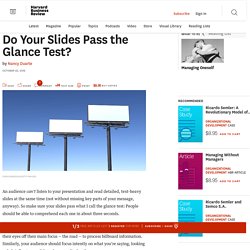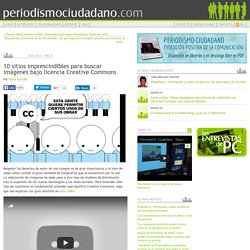

Garr Reynolds Official Site. Garr Reynolds Official Site. 1.

Show your passion If I had only one tip to give, it would be to be passionate about your topic and let that enthusiasm come out. Yes, you need great content. Yes, you need professional, well designed visuals. But it is all for naught if you do not have a deep, heartfelt belief in your topic. 2. You’ve heard it before: First impressions are powerful. 3. Do Your Slides Pass the Glance Test? An audience can’t listen to your presentation and read detailed, text-heavy slides at the same time (not without missing key parts of your message, anyway).

So make sure your slides pass what I call the glance test: People should be able to comprehend each one in about three seconds. Think of your slides as billboards. When people drive, they only briefly take their eyes off their main focus — the road — to process billboard information. Structure Your Presentation Like a Story. After studying hundreds of speeches, I’ve found that the most effective presenters use the same techniques as great storytellers: By reminding people of the status quo and then revealing the path to a better way, they set up a conflict that needs to be resolved.

That tension helps them persuade the audience to adopt a new mindset or behave differently — to move from what is to what could be. And by following Aristotle’s three-part story structure (beginning, middle, end), they create a message that’s easy to digest, remember, and retell. Here’s how it looks when you chart it out: And here’s how to do it in your own presentations. Craft the Beginning Start by describing life as the audience knows it.
After you set that baseline of what is, introduce your vision of what could be. Tecnologias de la Informacion y la Comunicaciones en la Educacion. Herramientas de creacion d.© UPV. "Clasificación Tradicional de los Instrumentos Musicales" Fichas con Mapas Conceptuales. Los Instrumentos Musicales. Órgano de tubos.

Aerófono mecánico Armonio Acordeón. History of music - Wikipedia. For the academic study of the history of music, see Music history.

Music is found in every known culture, past and present, varying widely between times and places. Since all people of the world, including the most isolated tribal groups, have a form of music, it may be concluded that music is likely to have been present in the ancestral population prior to the dispersal of humans around the world. Consequently, music may have been in existence for at least 55,000 years and the first music may have been invented in Africa and then evolved to become a fundamental constituent of human life.[1][2] A culture's music is influenced by all other aspects of that culture, including social and economic organization and experience, climate, and access to technology. The emotions and ideas that music expresses, the situations in which music is played and listened to, and the attitudes toward music players and composers all vary between regions and periods.
Eras of music[edit] Prehistoric music[edit] Copyright. Legal concept regulating rights of a creator to their work Copyright is the exclusive right given to the creator of a creative work to reproduce the work, usually for a limited time.[1][2][3][4][5] The creative work may be in a literary, artistic, educational, or musical form.

Copyright is intended to protect the original expression of an idea in the form of a creative work, but not the idea itself.[6][7][8] A copyright is subject to limitations based on public interest considerations, such as the fair use doctrine in the United States. Some jurisdictions require "fixing" copyrighted works in a tangible form.
It is often shared among multiple authors, each of whom holds a set of rights to use or license the work, and who are commonly referred to as rights holders. Creative commons. What we do. Creative Commons is a nonprofit organization that helps overcome legal obstacles to the sharing of knowledge and creativity to address the world’s pressing challenges. In order to achieve our mission, we: Learn more about Creative Commons through our collection of public reports and financials. For information about CC’s funding agreements, please see our Contributions Policy. Certain states require written disclosures for nonprofit organizations soliciting contributions. CC’s individual state disclosures are available here.
Creative Commons. Creative Commons Kiwi. Creative Commons Aotearoa New Zealand. 10 sitios imprescindibles para buscar imágenes bajo licencia Creative Commons. Respetar los derechos de autor de una imagen es de gran importancia a la hora de saber cómo utilizar la gran cantidad de fotografías que se encuentran por la red.

La adquisición de imágenes ha dado paso a otro tipo de modelos de distribución tras la explosión de las nuevas tecnologías y las redes sociales. Para entender este tipo de cuestiones es fundamental entender qué significa Creative Commons, algo que nos explican con gran sencillez en este vídeo: En España contamos con Coloriuris, un sitio donde “puedes registrar todas tus creaciones en dos clicks; ya se trate de textos, audio, vídeo o fotografía”. Está disponible para autores de 37 países con efectos legales en todo el mundo. Si eres un particular Coloriuris te regala el registro de tus creaciones de hasta 100 Mb.